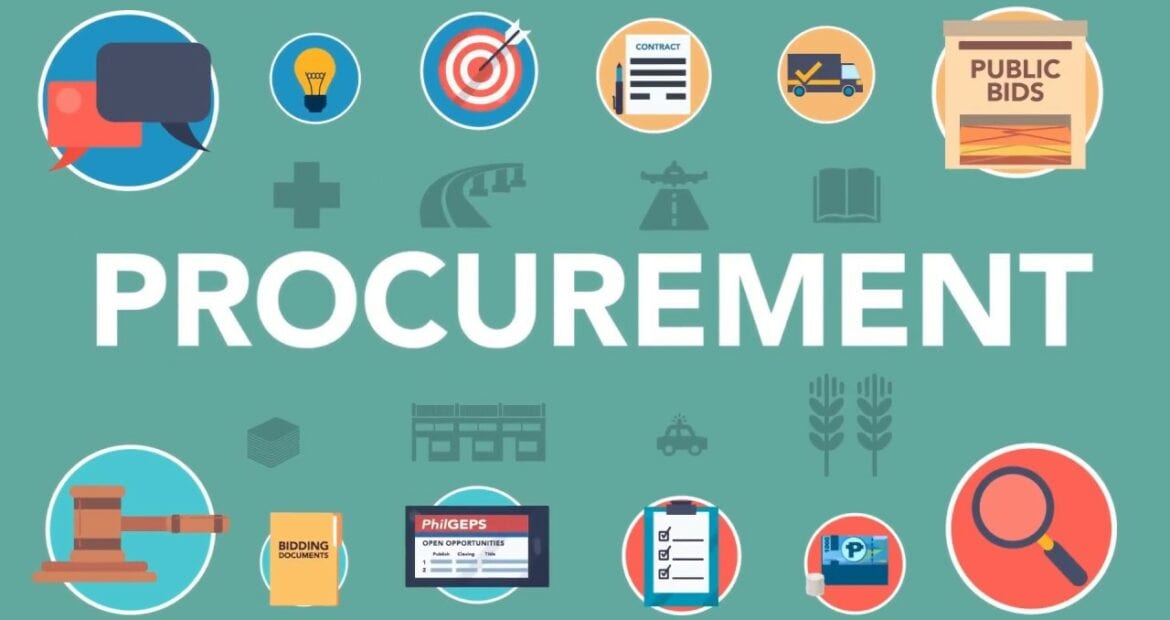Sep
12

Five Frustrations Procurement Professionals Will Understand
By Parker Sproul Procurement No CommentsEvery profession comes with its frustrations, but procurement comes with its own very specific set. If you’ve been in the business for more than a minute, you’ve probably wanted to put your head through your desk on more than one occasion thanks to these special procurement nightmares.
Are You Ghosting Us?
We’ve all had it happen—after weeks of back and forth, we message a supplier an important question that will impact, well, everything else. And we wait. And wait. Days pass. Weeks. Centuries… Okay, maybe that’s a bit dramatic, but when we are relying on this one piece of feedback in particular, it can certainly feel this way. If you don’t have the answer to our question, let us know. It’s okay. Just please, please don’t put us through the special hell of ignoring us completely while we search for a solution or an answer.
How Big Are Your Shoes?
Did you promise us the moon? Well, buddy, you’ve got big shoes to fill. Unfortunately, lots of other departments (cough, cough suppliers, marketers, we’re looking at you) have their toes in their arch supports. It’s frustrating when the people we rely on to fulfill our job duties overpromise and underdeliver. It leaves us backed up and with a whole lot of explaining to do.
T Minus 10 Minutes
We get it—sometimes genius strikes at the midnight hour (and often when we are furthest away from pad and paper), but changing plans mega late in the game is really difficult in procurement. If we’ve spent months planning for everything you need to execute your brilliant plan, changing everything last minute makes us shudder. Oftentimes, it simply cannot be done on timescale that suits everyone, and we’re the ones who end up taking the flak. Give us plans and give us time and we will give you the world, though.
The Ol’ Switcheroo
We’re planners. Have we mentioned that enough? We like plans. More importantly, we like sticking to plans. So, marketers and sales folks, believe us when we say that we are looking for this one particular item, especially if we say that’s all we’re looking for. Extra especially if we’ve already said it once. Give it up on the upsell and the cross-promotion, and we’ll thank you for it. Respect our already limited time and we’ll pay it back in spades with loyalty and not-too-many emails. At least the former, as long as you keep your prices reasonable and your delivery on time.
Dripping in Gold
Speaking of upsells, do we look like we’re made of money? We can’t break the bank on every new request, every outlandish marketing idea, every new and ingenius product idea. We have to save for a rainy day and prioritize our cash flow toward the best and most efficient option. You can stop calling us names—we’re not literally always looking for the cheapest option, even if it seems that way sometimes. We’re not trying to make your life harder. We’re trying to make our dollars take us as far as we can and sometimes that means saying things like, “No, I get that it’s a more ergonomic option, but we cannot approve another (sigh) standing desk at this time.”
Did this list make you want to cry into your keyboard? You can find relief at the Premikati Marketplace where procurement is easy (and way less frustrating).
Sep
12

3 Best Practices to Open the Silo Between Accounts Payable and Procurement
By Parker Sproul Procurement No CommentsSummary: Accounts payable and procurement work hand in hand, although many departments remain uninformed about the goals, metrics, decisions, and communications of the other. Businesses can breach data silos among the two departments by implementing Intelligent Spend Management solutions, utilizing technology and automation to its fullest, generating shared goals among the two departments, and generating a culture of effective sharing and communication. Creating flow between AP and procurement reduces risk, opens usable capital, increases business agility, and supports better supplier relationship management.
Why Is Alignment Between AP And Procurement Important?
Accounts payable and procurement can be seen like the left and right hands of an organization. Unfortunately, in many businesses, neither hand knows what the other is doing—even if they both report to the same person—which results in unnecessary fumbling, inefficiency, and lost profits. In an ideal scenario, finance, procurement, and supply chain all need to work closely together, sharing data and common goals for the greater good.
Procurement and accounts payable are an obvious place to begin when breaking down information silos because procurement is tasked with buying goods and services while accounts payable is responsible for paying for those same goods and services. Procurement and payment need to be combined under one reasonable, cohesive procure-to-pay (P2P) strategy in order for both “hands” to bring the best value to an organization.
A cohesive P2P strategy offers the following benefits to businesses:
- Positive working capital and achievable early payment discounts generated through realistic timelines between both departments
- Sourcing that involves more depth and insight than procurement can achieve on its own
- Better spend analytics based on data for more accurate cash flow predictions
- Better supplier relationship management via sharing and communicating goals, updates, and information about interactions
- Contract negotiation with suppliers that offers greater flexibility
Intelligent Spend Management: A Strong Plus
Intelligent Spend Management enables businesses to manage every source of spending across every category while aggregating spend data under a single, unified view.
SAP Ariba, the basis for our Premikati Marketplace, is a strong proponent and deliverer of Intelligent Spend Management solutions. Focus and agility are byproducts of “[understanding and using] data, transforming it from information into intelligence, and intelligence into value.” Intelligent Spend Management allows businesses to mitigate risks, collaborate effectively, automate their source-to-pay processes, and engage in rapid acceleration—toward fast-changing customer desires and new business models and revenue streams alike.
As it applies to AP and procurement, Intelligent Spend Management helps teams communicate and prioritize better, uncover hidden spend, and collaborate more effectively with suppliers and business partners.
Actionable Ways to Open the Silo Between Accounts Payable and Procurement
In order for a business to begin the process of integrating accounts payable and procurement in such a way to mitigate risks and unneeded spending, it must begin with a plan. The following are starting points for businesses to create a path toward open, effective procedures between AP and procurement:
Agree on Common Goals
It doesn’t how hard either side is working if they are each working toward conflicting goals. Both departments should agree on common metrics and goals that both work toward throughout the month and subsequently report to relevant executives. Cash flow goals should be shared and purchasing decisions made in accordance with these goals. One shared goal which can be acted upon immediately is to create and utilize a combined, up-to-date vendor master list that is devoid of duplicates and is clear about who maintains what responsibilities in regards to the list.
Use Technology To Its Fullest
Technology is the cornerstone of adaptable, agile businesses in the modern day. Not only can technology help mitigate risk through automated processes which reduce errors and fraud, it can also be a key factor in breaking down communication barriers between departments which previously maintained their own separate records and metrics. If both AP and procurement maintain data through technological means, then that data can be more effectively combined and utilized to make better business decisions and predictions.
One immediate way to opt in to technology to support effective processes between procurement and accounts payable is via adopting and Intelligent Spend Management system. Because data will be able to be viewed from a centralized dashboard, insights and intelligence quickly follow. Having this form of system in place can also guide other processes between departments such as which key metrics to prioritize.
Other disruptive technologies may also be of use during AP / procurement crossovers. SAP Ariba, basis of the Premikati Marketplace, utilizes the high-tech trifecta of AI, machine learning, and blockchain. These sorts of technologies can assist with safe record-keeping, automation, and predictive analytics.
Create A Culture of Sharing
Information hoarding is an ineffective approach in today’s business culture. Instead, opt for a sharing culture that understands boundaries—sharing at length, but efficiently. In conjunction with creating shared goals, each department should also share information related to their key metrics and goals, their progress, and offer solutions surrounding how the two departments can work together for overall success.
AP and procurement should share relevant information regarding invoices—such as unpaid, late invoices—and recent interactions with suppliers. Similarly, any vendor info which has changed should be made promptly available to employees in both departments, perhaps through the combined vendor list. In terms of efficiency, an action businesses can take right away is to set aside a time for sharing and questions between the two departments. If questions can be saved for the end of the workday, then constant interruptions are less likely to throw off the flow of each side’s work, yet needed questions can be answered to better inform decision-making and priorities, offering fast adaptability on a day-to-day scale.
An Intelligent Spend Management system is one way to combine effective, efficient sharing culture with technology for easily-accessible data for all.
Feel free to share your best practices or pain points below…we love to hear comments from those in the field!
Sep
12

For SMBs, procurement can be the largest area of spending, often representing 50 percent of sales revenue. For companies looking to send value to the bottom line rather than take it away, optimizing the procurement workflow can help.
In many cases, SMBs tend to focus more on overall operations rather than more specific processes. However, targeting areas like procurement for process improvement can help accomplish goals that go beyond dollars and cents – it can also improve productivity throughout the organization, leading to greater efficiency from end-to-end.
Build bottom-line value with these procurement strategies
To help you chart a new, more profitable course forward, here are our top strategies in procurement for SMBs:
1. Choose your supplier partnerships more strategically
If you have several buyers who tend to purchase from a range of different vendors, think about consolidating that spending into a smaller pool. Purchasing from fewer suppliers will help to streamline resources from many angles as it will reduce time you spend on sourcing and help you avoid excessive delivery fees.
Additionally, the more buying power you have with a specific vendor, the better the relationship may become over time, and it may be possible to negotiate bulk discounts based on the volume of business you do with them – a mutually beneficial situation that you could work to your advantage.
2. Optimize procurement processes
Within smaller business operations, there is often less attention paid to purchasing from department to department. There may not be dedicated personnel or a finance department to oversee PO’s, so purchasing is done ad hoc without much regard to the availability of funds, pacing, or cost of sale implications.
In the enterprise, these functions are consolidated, and often evaluated and substantiated by technology and data, providing buyers with oversight and the tools they need to make informed decisions. Without this valuable financial data, a company runs the risk of overextending themselves by over-purchasing or overspending on the items they need.
Implementing a system to govern and consolidate all spending decisions is critical to achieving this goal, but if done manually, with spreadsheets and through other methods, error does occur, and an inordinate amount of time is spent in managing the process. An appropriate technology solution should be applied, as it will provide immediate value, reduce error, and allow employees to focus on higher-value tasks.
3. Apply the latest procurement technology and tools
Today, SMBs have the advantage of being able to access enterprise-grade procurement technology and tools, giving them the same financial and strategic advantages as major industry players.
Procurement technology has many advantages, including:
- Cloud-based systems are easy to manage and always available, assuring real-time insight into procurement activities.
- The analytics delivered by procurement technology provides stakeholders with the ability to make data-driven decisions and optimize costs, improve processes, and streamline reporting workflows.
- An e-procurement strategy removes silos within the organization, enabling collaboration between departments and consolidating efforts, resulting in cost reduction and process improvement.
- Automation delivers great value to SMBs as repetitive tasks are accomplished efficiently and accurately, eliminating errors and improving the quality and voracity of internal data. Many SMBs spend an inordinate amount of time backtracking to find mistakes and often overlook small errors that add up over time. Automating these baseline processes improves accuracy and allows employees to devote their time to advancing business goals.
- Another great advantage to applying an e-procurement strategy is the ability to predict trends in spending. Analytics deliver a clear picture of spending patterns and help the organization prepare for what’s to come based on actual data rather than just conjecture and instinct. Companies can be better prepared for the future and will be able to provide leadership with more accurate projections on the road ahead.
- E-procurement also enables better risk management as it reduces overspending, redundancy, and costly errors in administration.
- Compliance, whether related to company policy or regulatory mandates, is easily managed with e-procurement. If this is a priority for your business, an e-procurement solution will support your needs.
Premikati Marketplace: Procurement Solutions for SMBs
Premikati Marketplace runs on the SAP Ariba™ Buying and Invoicing platform. Developed specifically with SMBs in mind, it provides a way for small-to-medium sized companies to take advantage of enterprise-grade procurement strategies that will help them grow and scale.
To learn more about what Premikati Marketplace can do for your organization, visit www.premikati.com/marketplace or call us directly to get started.
Sep
12

Summary: Sustainable sourcing has become a consumer and investor expectation which impacts businesses not only morally and ethically, but alters customer loyalty, price point, risk level, and more. Because SMBs make up the vast majority of global businesses, the combined global impact of ethical choices can alter the course of history as long as businesses take steps toward responsible procurement environmentally, socially, and economically.
Sustainable sourcing is at the forefront of planning efforts for many businesses as climate change and consumer expectations offer a clearer and clearer call to action. As SAP Ariba Live and the coordinating Sustainability Summitfast approach, businesses of all sizes prepare to learn how to further augment and optimize their approach to sustainability in the supply chain.
There are benefits to businesses outside of morality and ethics as it pertains to responsible procurement and sustainable sourcing.
On the financial front, sustainable product sales have risen nearly 20% since 2014 and sustainable fast-moving consumer goods (FMCG) have a CAGR of 3.5%, almost four times that of conventional products. Another point for the bottom line—Millennials and Gen Z are more inclined to buy sustainable and ethical products devoid of harmful chemicals and which support social responsibility, with 73% and 72% respectively willing to pay additional costs for products that meet these requirements, according to Nielsen. Additional customer loyalty and increased prices can make a major difference to an SMB’s growth. And it’s not just consumers who expect transparency and sustainability—investors are increasingly on the lookout for responsible practices within the companies they choose to support.
Government initiatives are another reason to pursue sustainable sourcing, because many places around the globe offer incentives for responsible action. Similarly, avoidance of legal trouble and hefty fines is a byproduct of ethical decision-making in the procurement process. Because many unsavory practices hide in complex supply chains, opting for transparent sourcing platforms can help SMBs avoid unexpected compliance issues.
SAP Ariba, through their Procure With a Purpose campaign, supports the full list of UN Sustainable Development Goals (SDGs) which include basic rights and expectations such as access to clean water and food, elimination of poverty, gender equality, education, and responsible consumption and production. In order to achieve these goals and many others along similar lines, SAP Ariba focuses on three pillars of sustainability: social, economic, and environmental—all of which can guide the process for SMBs who seek to practice sustainable sourcing.
Society
Social sustainability refers to human and workplace rights, while social ethicality often refers to supplier diversity and similar measures. According to the speaker at the 2019 Sustainability Summit, Givewith CEO Paul Polizzotto:
“Society is demanding businesses change the way they operate by acting more sustainably and with greater transparency – all while generating a positive impact on the world. There’s an incredible opportunity for procurement teams to amplify their organization’s impact, not only by prioritizing ethical suppliers butby sourcing from suppliers who add social impact sales incentives into these transactions to drive even greater change.”
- Transparency, not slavery
With more than 40 million slaves worldwide, it is important to expect transparency from all members of a supply chain, all the way to the original source. Transparency is the enemy of unsavory practices such as slave labor and is an important first step in any sustainable supply chain. SMBs can require risk assessments and reports on working conditions, even through trusted third parties, in order to reduce the chance that slave labor is part of any step in the creation of their products.
- Engage diversity
By working with historically underutilized businesses (HUBs) and minority-owned businesses, SMBs are able to opt for ethical business decisions that help the world economy as a whole.
Economy
Approximately 50% of the world’s population lives on less than $2 per day. By supporting sustainable practices in businesses who pay workers a living wage, SMBs can impact poverty worldwide.
- Support economic growth in underserved communities
By choosing procurement processes which support indigenous workers and other underserved communities, wealth is spread and business grows symbiotically in tandem with one another. Single origin products can help ensure fair exchange of funds for exports from indigenous regions, but this is only one method to engage this practice.
- Verify risk levels for fair labor practices
Because poverty is an issue that spans the globe, SMBs can use a risk management platform to help ensure they do not support forced labor or child labor and to verify that all workers receive a decent, sustainable, living wage for the time they put in—and that the hours expected of them are similarly sane. The Ariba Network and platforms built upon it such as the Premikati Marketplaceintegrate supplier risk management software to avoid pitfalls such as this.
Environment
We often hear of large enterprises which take on environmental issues. For example, L’Oreal and McDonalds have opted to nix deforestation from their commodity supply chains. Similarly, Danone—maker of Evian water—has been developing a new, more sustainable and recyclable makeup for plastic bottles to help eliminate the pollution crisis. However, SMBs can have a substantial impact on the environment by simply choosing to work only with sustainable suppliers.
- Cut out toxins
Choose suppliers who elect not to use toxic and ozone-depleting substances in order to reduce pollution as well as hazards to workers and even consumers. As demand wanes, suppliers will be forced to change their processes—and those who were ethical and responsible from the outset are rewarded.
- Say “no” to waste
In a world overrun by pollution on land and at sea, sustainability as it pertains to wasteis a must. Ways SMBs can apply this to their own sustainable procurement process include choosing suppliers who:
- Limit unnecessary packaging materials
- Create recyclable products
- Utilize recycled products in the creation of their own products
- Create reusable products
- Offer products which can be repaired rather than thrown away
- Use environmentally-friendly, renewable materials in production such as bamboo
Considering SMBs with less than 500 employees account for 99.7%of employers in the US, the power held by businesses of this size is formidable. By functioning in unison, SMBs have immense sway over the state of both business and the world we live in. It is through this majority power share that GPO platforms such as ourPremikati Marketplace—powered by SAP Ariba—offer a truly actionable opportunity for SMBs to engage sustainable sourcing practices and become stewards of our future, all the while saving time and money.
Sep
12
The Art of Simplicity and other Tips for MidMarket Procurement Pros
By Parker Sproul Procurement No CommentsMaribel Lopez talks with Marisol Buczynski Buchanon of Premikati on opportunities for MidMarket to take a leadership role in procurement.
Sep
12

Supplier Diversity: How it Improves Business, and How it Works
By Parker Sproul Procurement No CommentsSupplier Diversity: How it Improves Business, and How it Works
Diverse spend is an ongoing goal for companies large and small alike. For government contractors and their subcontractors along the supply chain, the goal of supplier diversity can even stand as a requirement to doing business.
Exacerbating the search for diverse spend, suppliers often don’t even realize their potential to benefit from formal recognition of their diverse supplier qualities.
Supplier diversity can therefore feel like an onerous goal at times, imposed on supply chain professionals and business owners who already face manifold compliance requirements and boxes to check elsewhere.
Fortunately, in almost any industry, supplier diversity initiatives can be successful on both the buy and the supply sides with an all-encompassing approach that utilizes business intelligence, researches outside knowledge, and takes proactive measures. (You’ve already made a good first step coming to this page!)
The benefits of supplier diversity
Most large companies have been striving to increase supplier diversity for decades. But just what is a diverse supplier?
In the case of supplier diversity where the U.S. government is concerned, the OFCCP – Office of Federal Contract Compliance Programs – provides the following major small business subcontractor categories:
- Disadvantaged
- Woman-owned
- Veteran-owned
- Service-disabled veteran-owned
- HUBZone (Small Business Administration-designated “Historically Underutilized Business Zones”)
With the U.S. federal government requiring those contracting in excess of $700,000 ($1.5 million in construction) on a deal to pursue subcontract according to certain percentages with the above small business categories, it becomes crucial for these businesses to know their supplier bases inside and out.
There are other categories outside of or overlapping with the above, too, such as foreign businesses and National Institute for the Blind (NIB) or National Institute of Speech and Hearing (NISH) affiliate businesses.
Supplier diversity’s benefits are not limited to satisfying government contracting requirements. Having achieved supplier diversity – either as a buyer, or as an entrepreneur who has attained diverse certification (more on that below) – one’s business becomes more attractive to outside companies looking to improve diverse spend overall.
Moreover, from a marketing perspective, the potentially unique approaches of diverse suppliers can bolster a company’s ability to navigate the U.S.’s increasingly diverse demographics.
Identifying diverse suppliers
For many corporations, supplier diversity is nothing new. To illustrate, CVM Solutions found in a 2017 report that 75% of supplier diversity programs have been in place for more than 3 years. In the same survey, however, only 25% of supplier diversity professionals rated their programs as “very effective,” signaling a gap between those who knowwhat supplier diversity is and those who achieveit.
Of acute relevance to small and medium-size companies is to know how to demonstrate supplier diversity. Luckily, doing so is a relatively simple affair thanks to the existence of Supplier Diversity Certification.
Major national-level certifying agencies include the National Minority Supplier Development Council (NMSDC), Women’s Business Enterprise National Council (WBENC), and the U.S. Department of Transportation DBE Program, and the SBA Woman-Owned Small Business (WOSB) Program. Other major certifications exist, with even the state of Ohio operating its own Disadvantaged Business Enterprise (DBE) certification program.
Knowing about certifications is only half the battle. Suppliers may not realize the business benefits of certification, and their customers may not think to ask. Procurement supplier business surveys should always ask in plain terms about suppliers’ knowledge of diverse supplier certification beforeestablishing whether they have any! This simple question can save lots of time, money, and calories for all parties involved.
For small and medium businesses especially, the art of sourcing diverse spend can still seem excessively time-consuming, cost-intensive, or just overwhelming to approach. Easy-to-use tools exist to streamline this process.
Integrating diverse suppliers
Dun & Bradstreet (DNB) is meanwhile known for its deep supplier sourcing database, and assigning a D-U-N-S identification number is free for all businesses required to register with the U.S. Federal government for contracts or grants.
New networks and databases are cropping up to meet the unique demands supply chain professionals face, like in supplier diversity. Premikati Marketplace, an SAP Partner-Packaged Solution, enables diverse supplier sourcing with ease.
SAP Ariba is a major software suite that supply chain professionals use to drive all sorts of business decisions. Using SAP Ariba in a turnkey, in-browser navigation system, Premikati Marketplace connects suppliers (including diverse) with buyers. It is free for suppliers to set up, with no costs or fees to maintain.
With Premikati as a WBENC-certified woman-owned business, enhancing users’ supplier diversity connections is a key function of its Marketplace. New suppliers have the opportunity to connect with potential buyers, and potential buyers to new suppliers, thanks to the low barrier to entry design of the network.
From electronic requisition processing to supplier information queries, Premikati’s Marketplace solution is easily tailored to diverse supplier integration.
Every supply chain initiative poses unique opportunities and challenges, and supplier diversity efforts are no exception. For a more personal touch to your unique supply chain initiatives, contact Premikati’s experts for a real human’s ideas and insights on how you can improve supplier diversity and enhance other efficiencies in your company’s supply chain now.
About PREMIKATI
Founded in 2009, Premikati, Inc. is a WBENC certified woman-owned Supply Chain Business Process Outsourcing (BPO) firm, providing cost savings and financial, contractual and supplier risk mitigation services to purchasing organizations for mid and large enterprises while leveraging best-in-class purchasing processes and technology. Premikati has partnered with SAP and is one of only five companies globally to have been granted the most exclusive partnership level with SAP Ariba, as a BPO Partner.
Sep
12

As one of only eight companies in North America that have the ability to implement SAP Ariba Snap solution that is targeted at mid-market companies, we at PREMIKATI have compiled a list of frequently asked questions and their answers to help you decide if your organization is ready to take the next steps into solving your procurement obstacles and meeting your business objectives.
Overview and Key Differentiators:
What exactly is SAP Ariba Snap and how does it differ from standard SAP Ariba?
Snap is an implementation of SAP Ariba Buying and Invoicing and encompasses the critical elements of a procurement foundation at a minimum of complexity.
What is the process of implementation?
PREMIKATI is able to take your business live with SAP Ariba Snap in under 12 weeks. You will get best practices on Day 1 out-of-the-box which can be adjusted during implementation and over time. In order to maximize the return on investment, we recommend that SAP Ariba’s Spot Buy marketplace be turned on immediately. We want you to be transacting in 2 weeks or less!
(See more about the incredible SAP Ariba Spot Buy Marketplace!)
Supplier enablement of the initially targeted suppliers are performed by Premikati. This is a critical aspect of the successful implementation and has been fully integrated into the implementation process. We train your team so you can be self-sufficient as you add suppliers over time.
Spot Buy:
Does the SAP Ariba Spot Buy Marketplace come with SAP Ariba Snap?
Yes, Spot Buy is included and can be ready for transacting early in the implementation process.
One great thing about Spot Buy is that you can control content by commodity. For example, the administrator has the ability to toggle on and toggle off what content your users are allowed to see. In addition, approval workflows and cost center information can be added to any purchase. These are unique value props to Ariba Marketplace. You choose the content for your users, no matter the number or location – a feature that NO competitor has.
Do users in countries such as Brazil, Argentina, Mexico, UK, Germany, and Australia have access to Spot Buy content immediately or is that limited to the US only?
The marketplace is growing fast! SAP Ariba Snap has up to 60 million SKU`s from sustainable, and vetted suppliers. It is available for users in US, Canada, UK, and Germany today. Mercateo is the marketplace provider for EMEA. Recently, SAP Ariba signed agreements with Mercado Libre that will make the marketplace available in Latin America.
Guided Buying:
Does Guided Buying come with SAP Ariba Snap, and if so, can you configure other categories to the guided buying landing page?
Yes, Guided Buying is included. While you can easily add additional categories that are specific for your business, with Snap you get pre-built categories with content and forms for:
- IT & IT Services
- Office Supplies
- Advertising & Printing
- Marketing Services
- Financial Services
- Legal & HR Services
- Facilities / Maintenance
- Travel
(See more about SAP Ariba’s Guided Buying)
Technical:
How do approval processes work? What do they look like?
You will receive SAP Ariba’s best practice approval workflow out-of-the box. You can approve via the application, via email, or by mobile device. Approval workflows have tons of flexibility. There are parallel approvals to accelerate process. There is a concept of a watcher, and user approval groups. Out of the box approvals include role, dollar value, special situation. This helps to minimize the need to build customizations.
How does Ariba & ERP’s integrate? Is there a standard set of integration scenarios for each process within Procure-to-Pay that no special development is needed if SAP best practices are followed?
Perhaps the most valuable aspect of Snap is the pre-determined flows, processes, and approvals out of the box. The structure is both robust and complete, essentially eliminating the need for customized integration. There are few instances where the custom integration justifies both the up front and ongoing maintenance costs. With SAP software, there are 170 native integration points. The number of integrations is 8x of any competitor and covers the entire Source-to-Settle process.
Does this apply to non-SAP customers as well?
Yes. Ariba Snap is ERP Agnostic and will deploy in <12 weeks. 42% of Ariba customers are non-SAP.
Essentially all ERP systems can now be integrated to Ariba.
Are analytics provided? If so, how is reporting presented and managed?
Yes, analytics are provided which are focused on the P2P lifecycle. As part of Snap, SAP Ariba has provided end to end capabilities to support the entire procure to pay process. All of the basics are reported on (approvals, spend by categories, invoices exceptions, accruals, etc.) It is possible to set it up to have a weekly report sent to your stakeholders directly from the tool, or you may download in Excel. Additionally, any data element captured can be reported with an unlimited number of customized reports that your team can create easily.
Upgrades:
If our company outgrows SAP Ariba Snap, do we have to redeploy/repurchase SAP Ariba?
Absolutely not! SAP Ariba Snap is the same full Buying and Invoicing solution deployed at Large Enterprise customers but the focus is on the features and functionality that are critical to growing businesses and deploy only those features. If you need additional features in the future, these are already included in your license and you can toggle them on at any time.
The beauty of SAP Ariba Snap is that it is a solution that is built to grow in complexity as your business matures. With implementation, we start with the key foundations that will give you the fastest time to value in key spend categories. Once the foundation is set you can add those features and functionalities that best meet your needs while minimizing cost and operational risk.
What does SAP Ariba Snap cost? Is the price determined by Spend Volume? by PO? Or transactions? Or connections?
Pricing is done by volume of Spend and the of the number of documents (PO and Invoices per year). Unlimited users are allowed so everybody in your company to have flexibility to access the tool without additional cost.
My Suppliers:
What is the process for suppliers to join the Ariba Network?
Suppliers can join the network at discovery.ariba.com but they are also invited to the Ariba Network from the buyer in their Ariba site. This can be done as an invitation or when a PO is sent to supplier prompting the invitation. Suppliers are considered customers too. SAP Ariba has used many UX principles to dramatically ease supplier interaction on the network.
What are the fees for Suppliers with SAP Ariba Snap?
Your suppliers can transact for free on the Ariba Network. They have the ability to send PO`s, Invoices, Order Confirmations, Ship Notices, and more. (Learn more about Light Enablement from SAP Ariba)
Why should we buy SAP Ariba instead of a competitor’s product? Here are a few highlights:
- Fast time to value (<12 weeks)
- Best practices built in
- Access to Spot Buy marketplace (content engine) that you control by commodity
- UPGRADE Path without having to “upgrade”!!!
- Local Resources – local language support and real-delivery expertise
- Integration is simple and easy
- Commercial flexibility i.e. Unlimited users and low subscription price
- Suppliers can transact for free on the Ariba Network via Light Enablement
About PREMIKATI
Founded in 2009, PREMIKATI is a WBENC certified woman-owned Supply Chain Business Process Outsourcing (BPO) firm, providing cost savings and financial, contractual and supplier risk mitigation services to purchasing organizations for mid and large enterprises while leveraging best-in-class purchasing processes and technology.
Sep
12

When a company decides it has a need for a Contract Management software, the first step is generally to send out an RFI/RFP. A number of weeks and many pages of responses later, the field is generally narrowed to a couple of contenders. Then comes the demos… The team watches each vendor demonstrate their technology, usually with fairly little difference between them. Reporting, templates, clause libraries, redlining, and electronic signatures are usually the top things that everyone wants to see.
At the end of the day, since most of the top tools can all accomplish the same things, two factors typically make the decision. 1) The one that the team deems most “user friendly” and 2) price.
Once implementation is underway, the team starts to realize that they simply aren’t ready with templates and a clause library. Creating those from scratch takes a considerable amount of effort, particularly from an already overburdened legal team. They also realize that redlining might not work quite as easily as it was shown in the demo. These two items are then pushed off to a Phase II (which often never occurs) and the system is basically used as a repository.
The software vendors typically do not have different “levels” of their software at different price points. If you want a “repository only” solution, you would need choose a lower cost, less sophisticated software, effectively eliminating a progression path towards those features such as templates, clause libraries, and redlining that can be beneficial as your organization matures.
With Premikati recently becoming a BPO Partner of SAP Ariba, we have opened up a new set of options.
Premikati can now purchase and operate the SAP Ariba Contract Management Professional software on your behalf. We have two paths, one for Enterprise customers, and another for companies below $500MM in annual revenue.
First, for the Enterprise. Premikati can purchase an individual realm to operate on your behalf. Frankly, our status as a BPO Partner enables us to buy it at a significantly lower price point that you can. Our team will own and operate the system on your behalf, performing Contract Administration Services and, of course, all of the system administrative functions as well. This allows your team to focus its energy on more strategic opportunities, not the tactical day to day activities of keeping track of contracts. When you consider the total cost of ownership, you will be hard pressed to find a service/solution that provides more value for the price.
For companies below $500MM in revenue, we have a whole new way of thinking.
Since we realize that initially you most likely only need a “repository” with reporting and the ability to do electronic signatures, that is all you are going to pay for.
Depending on a variety of factors, our pricing starts as low as $30K for an annual subscription that includes Contract Administration Services and all system administration.
Implementation is similarly value priced starting at $25K with a Go-Live in as little as two weeks.
This is still for the full version of the Ariba Contract Management Professional system although integration with other systems is not available in this situation. However, during your maturation as an organization, both in revenue and sophistication, we can always move you over to an Enterprise realm with ease and no downtime.
______________________________________________________________________
Premikati is a certified Woman Owned Management Consulting and Legal Process Outsourcing firm, and an SAP Ariba Silver Partner, that is specifically tailored to Procurement and Supply Chain.

